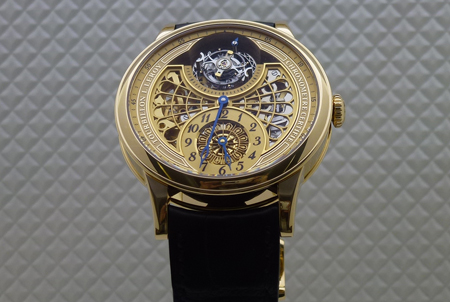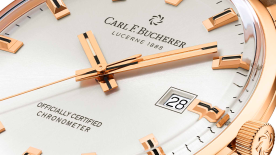Though Piaget had already been manufacturing movements for 129 years, it wasn’t until 2003 that the traditional maker introduced its own flying tourbillon, representing a definitive step into the complicated side of high watchmaking that collectors had been missing in the luxury brand’s line. The Emperador Tourbillon boasts a whirlwind located at the 12 o’clock position of very slim Caliber 600P, only 3.5 mm in height including the titanium tourbillon cage – an element of tourbillons that always juts out from the base movement and extends their thickness. The height of the entire encased manually wound watch, limited to just twenty pieces, was only 10 mm.
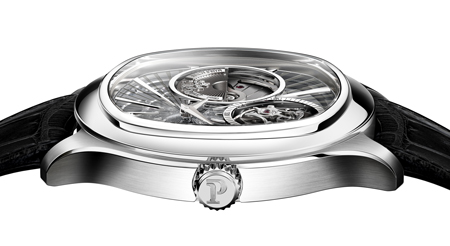
Eight years later, at SIHH 2011, Piaget debuted the Emperador Coussin XL Tourbillon, a thin timepiece whose Caliber 1270P, only 5.55 mm high, winds the mainspring by use of a white gold micro rotor that is visible on the dial side. At the time of its release – and all the way up to Baselworld 2013 – this timepiece held the record for the world’s thinnest self-winding tourbillon watch: its white gold case is only 10.4 mm high. The designers were very clever, reengineering the entire mechanism to accommodate the interesting visuals: the off-center arrangement of the time display (3 o’clock) and micro rotor (9 o’clock) necessitated an off-center display for the tourbillon window, which can now be found at 1 o’clock. This past SIHH saw Piaget launch two new limited edition versions of it: one with a black ADLC-coated bezel and a black, ultra-thin automatic mechanical tourbillon movement and another version in rose gold set with brilliant-cut diamonds.
Record shattered
Throughout its recent history, Piaget has set record upon record for ultra-thin movements. This year, however, the “king of thin” had to concede both of its records for encased tourbillons. In terms of manually wound examples, Piaget has been overtaken by the Mastergraff Ultra-Flat Tourbillon, whose 6.95 mm high rose gold case is 3.05 mm flatter than that of the Emperador Tourbillon. It houses a 3.55 mm-high tourbillon movement.
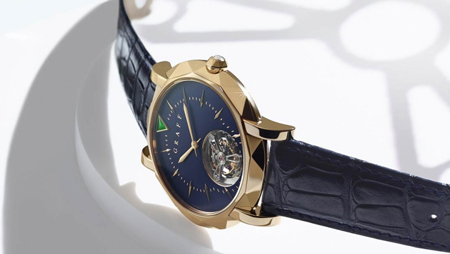
Having spent over a year in the research and development of Graff Caliber 4, the technicians of the brand best known for its luxurious jewels spent a great deal of time analyzing how to lose height by reengineering dial finish, flatness of the hour and minute hands and hollowing out as much gold material as possible inside of the case. Rethinking these elements allowed Graff to gain the maximum amount of space within the case.
“Creating the MasterGraff Ultra-Flat Tourbillon was a big challenge,” explains Michel Pitteloud, CEO of Graff Luxury Watches. “However, we have an incredible team of talented watchmakers and engineers that I knew would be able to overcome any challenges or obstacles we would be faced with. As you can imagine, one of the hardest tasks was to find a way of making one of the thinnest flying tourbillons. I think we have succeeded relatively well!”
Other noteworthy thin manuals
Encased in its 43 mm platinum shell, “newcomer” Julien Coudray’s solid platinum tourbillon Competentia 1515 is only 9.82 mm high, and includes major movement components also crafted in solid platinum, a four-year service indicator in enameled 18-karat gold (shown at 12 o’clock), a power reserve indicator at 8 o’clock, and a day/night indicator seen through the sapphire crystal on the case back. Most certainly, setting a record for the thinnest tourbillon was not watchmaker/founder Fabien LaMarche’s goal in creating this model, but boasting all those added functions within a caliber only 4.85 mm in height, he came darn close anyway.
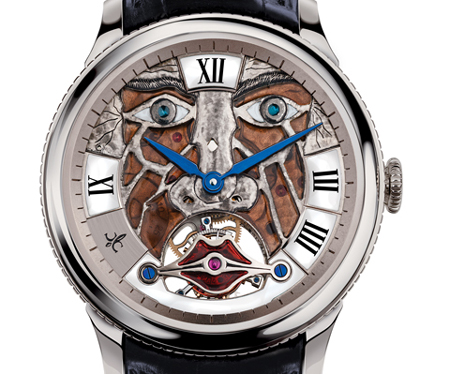
Though one might never suspect it, Richard Mille’s RM027 (the original 2010 tourbillon worn by tennis player Rafael Nadal, crowned French Open champion for the eighth time on Sunday) has one of the thinnest manual tourbillon movements on the market. One would never suspect it since stately case dimensions are a signature element of Mile’s timepieces, and this one measuring 48 mm x 39.70 mm x 11.85 mm is no exception. However, the robust movement is almost delicate in its measurement: 30.20 x 28.80 mm x 7 mm. At a weight of 3.83 grams (the watch without strap weighs 13 g) it is by far the lightest tourbillon in existence.
Thinnest automatic
It seemed that the watch world drew a collective breath at Baselworld, as Breguet rather offhandedly soft-launched the thinnest automatic tourbillon in the world, due to appear at retail only in 2014. Encased in a 7 mm-high rose gold case and displaying a power reserve indicator for its incredible 90 hours of energy, the Classique Tourbillon Extra-Thin Automatic, Reference 5377, runs on brand-new Caliber 581DR, which is a mere 3 mm in height – including a bi-directionally winding platinum rotor that is positioned so as not to add to the height. Its case diameter is, however, still just right, coming in at 42 mm. This new movement, the subject of two patents unrelated to its height, is finely engraved and can even be admired through a sapphire crystal case back, seldom used on ultra-thin cases as it adds to thickness.
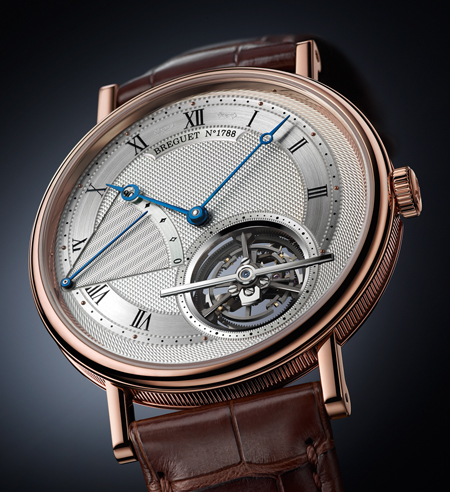
The height of LeRoy’s automatic Osmior regulator-style flying tourbillon comes close to that of Piaget’s, with a total case height of 10.7 mm (movement height 4.90 mm) – despite being wound by a conventional, full-sized 22-karat gold rotor. Inspired by original LeRoy museum pieces, it does contain a surprisingly ultra-modern element: an escape wheel and lever manufactured in synthetic diamond, which eliminates the need for lubrication at these points.
Yes, I would say that thin is definitely in.
